I have just finished my first ultra-cycling experience, GranGuanche Audax Gravel, a 700km race with 16,000 metres of climbing across the Canary Islands. Unfortunately, I was able to do only 580km and 12,500m of it because of an agonising pain in my Achilles, which made me prioritise my health over finishing the race. However, the three days and four Canary Islands that I experienced as part of this race gave me a good taste of ultra-cycling and confirmed how amazing the Canary Islands are for cyclists.
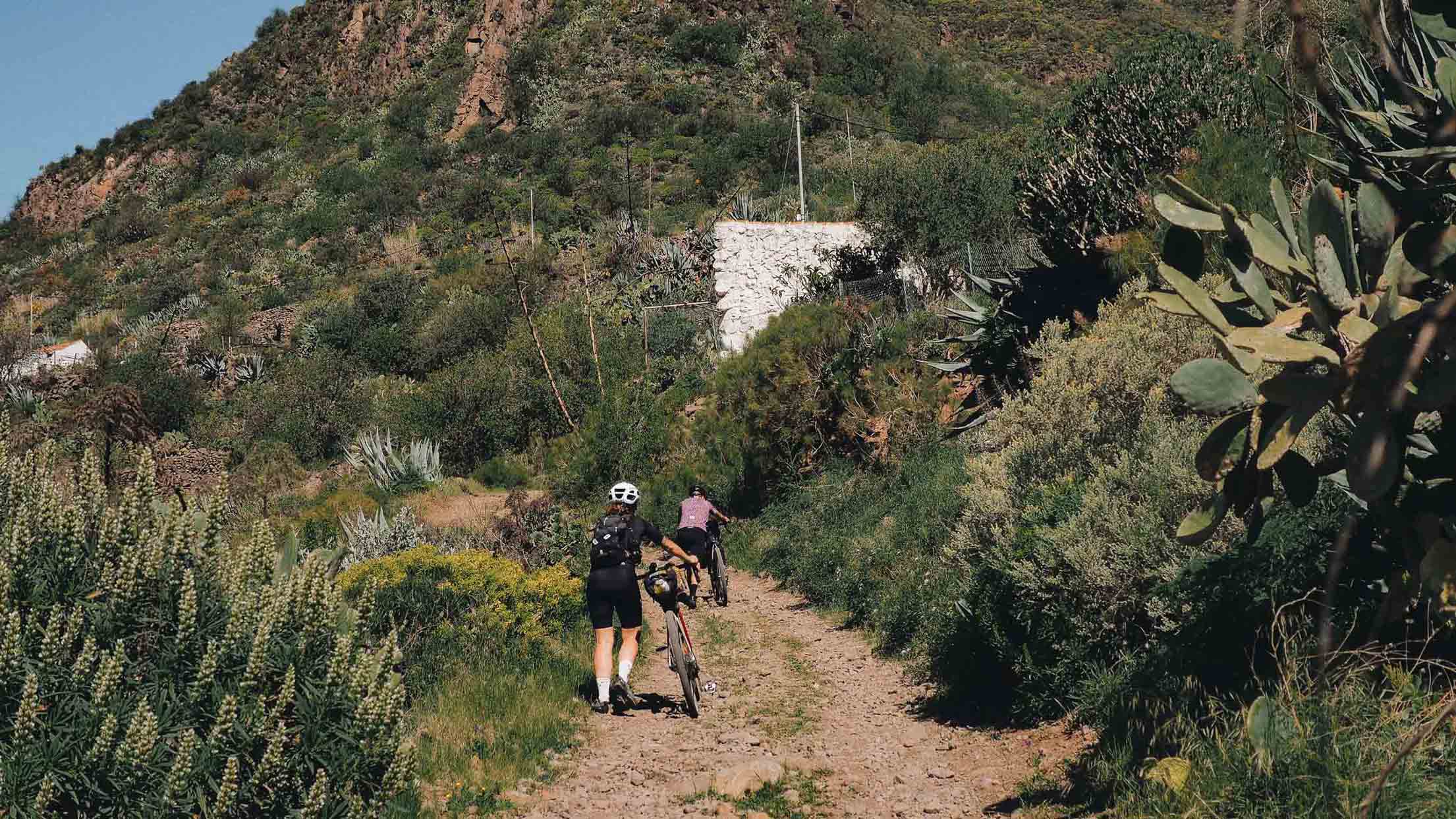
When it comes to stepping out of your comfort zone, testing your limits and meeting other like-minded people, ultra-distance events are just the thing. It’s not easy to get the sort of headspace you experience during a race like this while you’re at home, so if you want to test what your body and mind are capable of then ultra-cycling is a great way to do so. That was also a reason why I wanted to try it out. I really enjoyed the first two days of the race and was amazed at what my body was capable of even though I had only cycled outside six times this winter and ridden handful of times on the home trainer.
Image courtesy of Lucie Denis
Lanzarote and Fuerteventura
We started the race from Lanzarote at 10 pm and cycled overnight across the island. My goal was to keep it as easy as possible since I knew I would pay the price of riding too fast in the coming days. Everything went as planned: the riding felt good, I arrived at the harbour at 4:30 am and slept for 2.5 hours before the ferry to Fuerteventura.
"Views, snack breaks and hard parts are best when shared with company."
What makes GranGuanche so special are the ferries. If you miss one ferry, you may have to wait 12h or even 24h before the next one. Thus, for me it turned into a race against the ferry timetables. The first challenge was the ferry from Fuerteventura to Gran Canaria – I had 9 hours to ride 160km and 2,300m. Before the event, I had decided there was no chance I could make it to this one, but I decided to give it a go and start riding. It was the right decision as we made it to the last ferry to Gran Canaria and I was still feeling good and strong. What made the ride in Fuerteventura even better was that I rode it with Lucie Denis, a bad-ass female rider from France. This day proved that views, snack breaks and hard parts are best when shared with company.
Photo courtesy of Matteo Minelli
"Chamois cream became my dearest friend"
Gran Canaria
We booked a hotel from Las Palmas, ate well and slept for five hours until 4:30am, before starting the 140km and 3,500m ride across Gran Canaria. I have never climbed more than 2,500m of elevation in one day so I must admit I was slightly apprehensive. We made our way up, slowly but surely. Simon had joined me and Lucie so now there were three of us pushing each other forward. We stopped for breakfast and then a second stop for a real coffee before we headed out of the town to the remote section with the big climb. At first, the climb was long and hard, then steep and way too hard so we had to hike-a-bike to get out of the canyon. Before the final push to the top, there were two beautiful gravel loops. By now I was already feeling my legs and saddle sores a lot, so chamois cream became my dearest friend. If anyone tells you that you don’t need chamois cream for ultra-cycling event, don’t listen. When you’re in the middle of nowhere you will prefer to thank yourself for having it in your bag rather than curse yourself for not having brought it when the mere thought of sitting down in your saddle makes you want to cry.
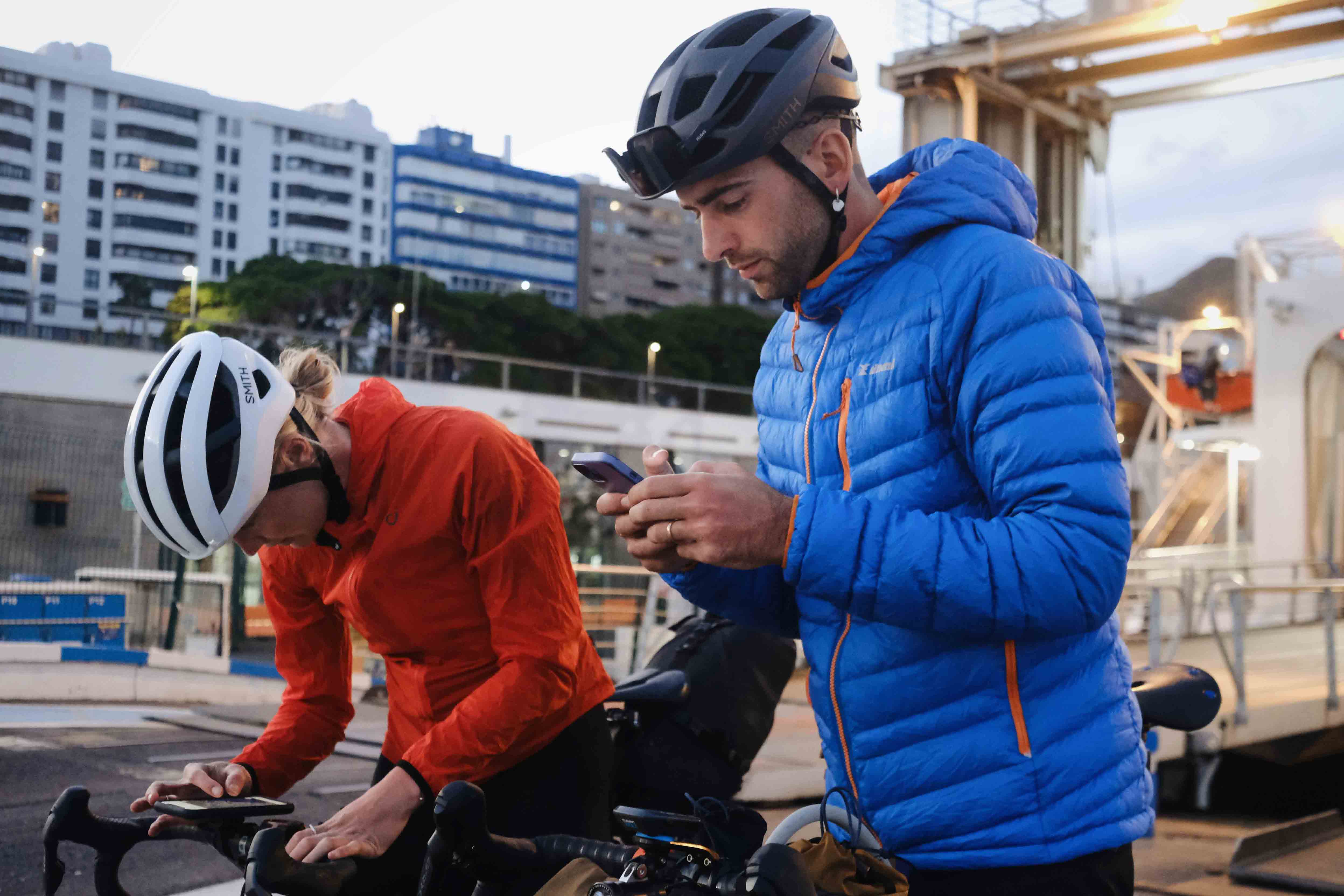
Image courtesy of Lucie Denis
"The way down from the top of Llanos De La Pez was the longest and one of the most stunning gravel descents I have ever done"
Anyway, we finished the climb, still feeling relatively alright considering the circumstances, layered up and started the descent. When the words “who the heck thought of cycling here when you could just drive here with a car?” slipped out of my mouth on the last part of the climb, you could tell I was done with climbing. We found a nice restaurant and stopped for a proper lunch—perhaps getting a bit too comfy sat down as we spent 1.5h at the restaurant and missed the 4 pm ferry. Oh well, we enjoyed it and the 6pm ferry would be fine. After the break I struggled for a while with the saddle sores, until everything was numb enough for me to focus on cycling again. The way down from the top of Llanos De La Pez was the longest and one of the most stunning gravel descents I have ever done. We were amazed by beauty of it and even though we knew we had to keep going so we wouldn’t miss the 6pm ferry we couldn’t help but stop to take photos. We made it to the ferry with 10 minutes to spare despite the last-minute roadworks that held us up for over 5 minutes and raised our stress levels.
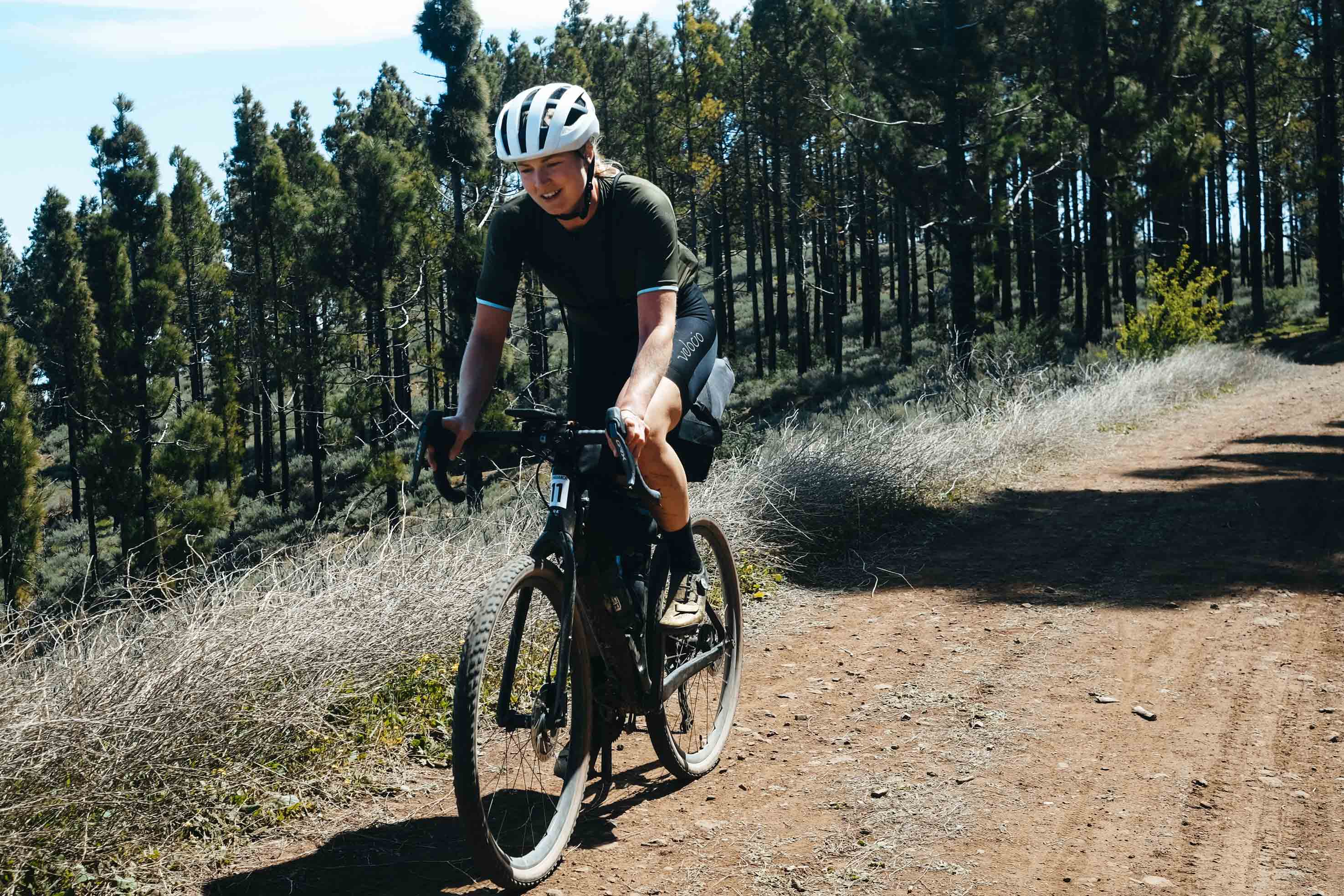
Image courtesy of Lucie Denis
Tenerife
We arrived in Tenerife, stocked up on Bepanthen bebe – classic nappy cream – for our saddle sores, plus food and water, and had one last tasty gas station coffee before starting the 170km and 4,500m ride across Tenerife. We really enjoyed the first 6km of flat before starting the first part of the climb to La Laguna. Luckily it was paved and quite mellow, so it was doable even at night. However, after the full day in Gran Canaria, 45km and 1,200m of climbing felt tough and the temperature kept dropping as we climbed. We decided to camp in a courtyard in La Laguna – the sketchiest spot you can find according to our local photographer friend. (I am glad we didn’t know that when going to bed!) Having had 2 hours of bad sleep, we woke up at 3:45am and kept riding – still 130km and 3,300m to go before the one and only 5:30pm ferry to El Hierro.
Image courtesy of Lucie Denis
"By afternoon I was so exhausted that the only thing I could do was to cry"
The next hours were fine until we turned on to a small gravel road that led us deeper into the forest and eventually all the way up to the bottom of Mount Teide. It was freezing – the temperature had dropped to 4°C. Besides being cold, the muddy and rocky gravel track made it hard to eat and drink enough. That’s when the problems began. We stopped to have a snack and a short break, but I was struggling to eat even though I knew I should. We kept riding and I started losing power but couldn’t force myself to eat. Eventually, I couldn’t keep up with the others, so I tried to find my own pace, taking more breaks but still moving forward, slowly and surely. By afternoon I was so exhausted that the only thing I could do was to cry. I had to lay down a couple times to rest, breathe and cry. I forced myself to eat something before I kept going again. I don’t think I have ever moved so slowly with my bike. My legs were empty – it felt like I was spinning two empty nuggets on the pedals. The only thing I wanted was the climb to end but it just kept on. It felt like the longest climb of my life – and it was.
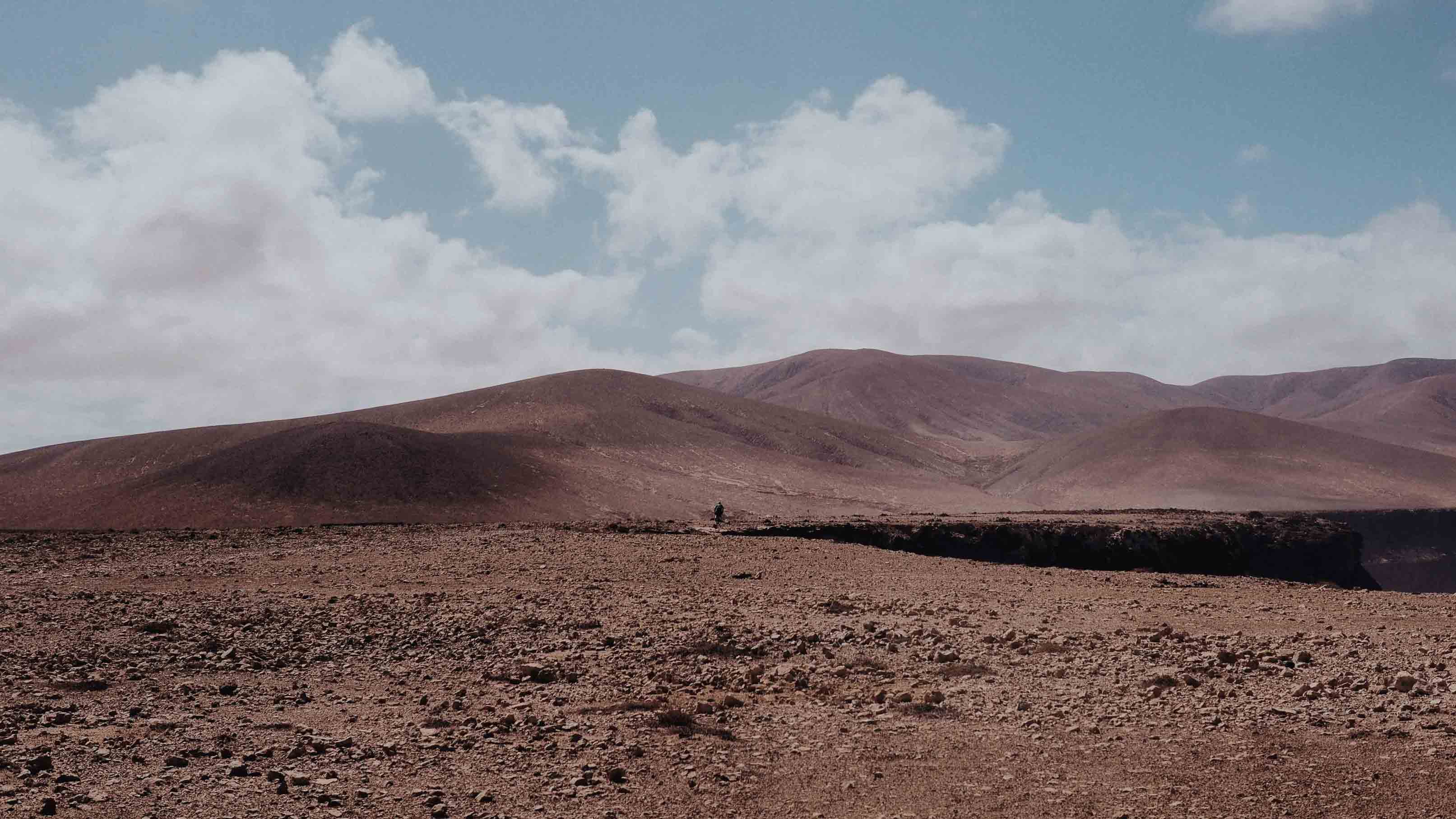
I was also running out of water as there was no opportunity to refill on the climb, which definitely didn’t help the situation. After a long and slow battle, I finally reached the road and found a restaurant after a few kilometres where I was able to stop and refill my bottles. I should have eaten but the only thing I could get down me was a cold Coca-Cola. After sitting down for some time, I got back on the bike, but I was hurting a lot and my Achilles had started to bother me on the climb. The saddle sore made sitting down extremely painful. I didn’t think I could make it to the ferry anymore; I was too tired. Too tired to care, even. I just wanted to get off my bike.
"I had to keep pedalling despite going downhill. It crushed me"
The long-await descent came next, giving me the first break in hours. I was convinced things would get better now – but then came the headwind and I had to keep pedalling despite going downhill. It crushed me. When I reached the flat section of the descent with the strong headwind, I got off the bike again in tears. The only thought in my head was that I just want to get out of here NOW. Unfortunately, the only way to do so was by bike. While part of me didn’t care about catching the ferry anymore, at same time another part of me did not want to give up. I texted my family to say I was feeling absolutely horrible and wouldn’t make the ferry. But then, I check my komoot and it showed me I could still make it despite the flat section and one more uphill. I forced myself to eat the last bit of my sandwich and couple M&Ms and got back on the bike.
Image courtesy of Lucie Denis
It was time to get out of there. The tiny amount of food made me feel little stronger – there was 6 M&Ms in my legs instead of zero. I decided that no matter how bad it feels, I’m going to power my way to the top of the last climb and after that there’s a 40km descent waiting for me and I don’t need to do anything anymore. 1-2-1-2-1-2, I kept repeating in my head and got to the top of the last climb, FINALLY. Layered up, I started descending. This is what I like, I thought but still, I was so tired that I was crying. Also, the pain in my Achilles tendon had got worse. Even just spinning my left leg hurt so I kept my feet still. When I reached the city, I could only pedal using my right foot. But I made it to the ferry, I made it with an hour! I was happy, tired and broken. I ran into Lucie and Simon, cried some more and gobbled some French fries with them before catching the ferry. I was confused – I had made it to the ferry, but I didn’t know what I should do because my Achilles really hurt. I decided to get a good night’s sleep in a hotel and decide in the morning.
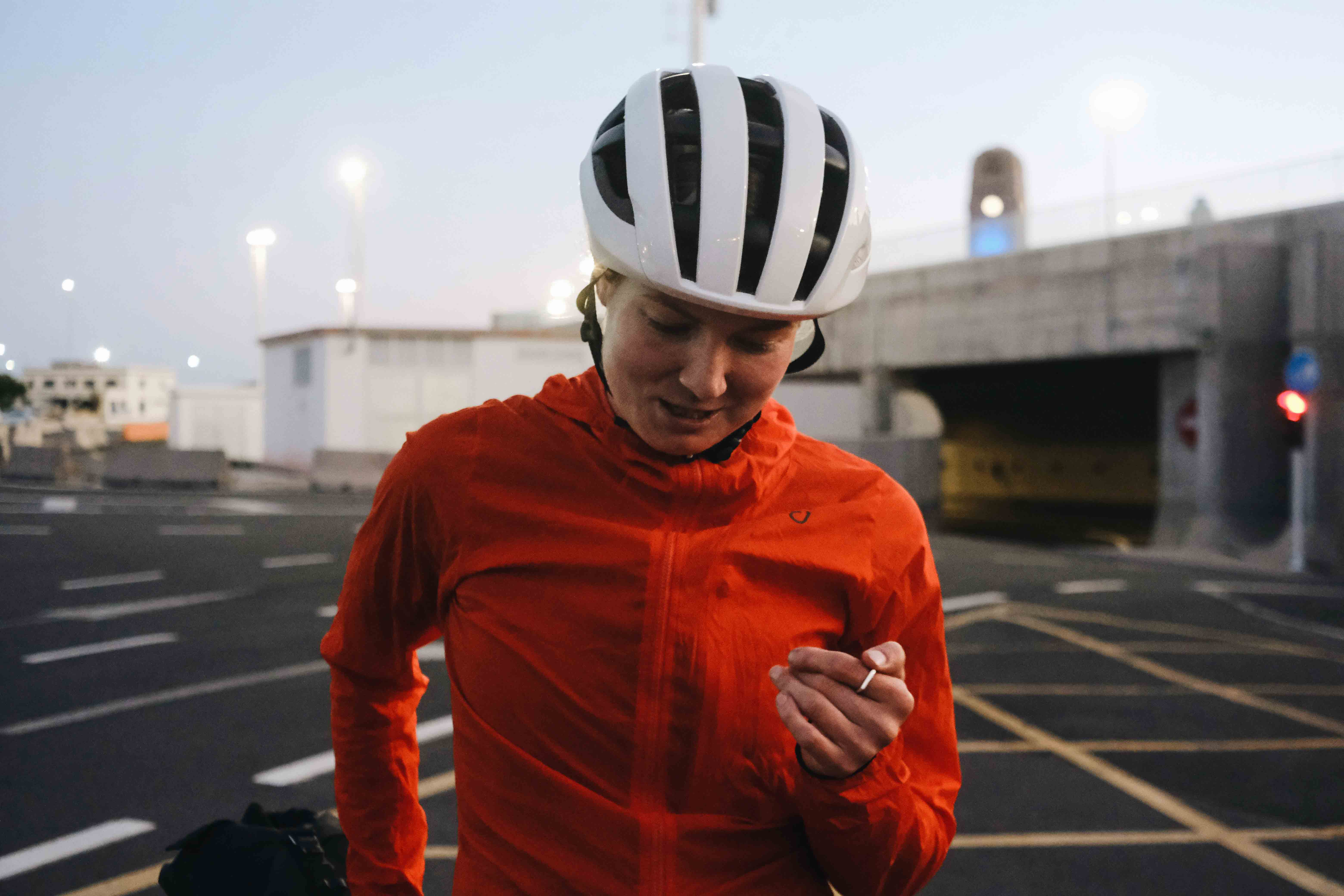
Image courtesy of Lucie Denis
El Hierro and reason to stop
To make my night worse, I fell while getting off the ferry in El Hierro. I hit my right leg hard on the metal deck and it hurt more than anything for a while. By night time, I couldn’t bend my leg anymore and knew I was going to get a massive bruise. It was shattered. I dreamed of cycling the whole night and by morning, I could bend my right leg again and my left Achilles tendon only felt a little tight when moving it in bed, so I decided to continue riding.
"I didn’t know what to do - ride or not ride"
But my body had other ideas: Just walking 50 metres to breakfast was enough to bring back the sharp pain in my Achilles. I didn’t know what to do: ride or not ride. I wanted to keep riding, I had made it this far, I had even caught the last ferry so now I could just cruise through El Hierro and enjoy it at my own pace. But at the same time, I didn’t want to worsen the already intense pain in my Achilles pain so that I wouldn’t be able to ride for months. That’s when I had to stop and understand that no matter what race it is, it doesn’t make sense to risk your health. Riding an extra 110km now could mean weeks or months off the bike. Riding my bike and being able to move is everything for me, so sacrificing that for one ride now didn’t make sense. I decided to scratch.
Image courtesy of Lucie Denis
I decided to give my body one final chance: It hurt as soon as I got on the bike. More tears. More disappointment, but I knew it was the right decision. I’m doing this for fun and risking my long-term health is not fun. It’s not easy to recognise where the limit between good and bad pain is but I could tell I had crossed the line. I wouldn’t have been able to forgive myself for making the Achilles worse and then needing to do rehab for months instead of making a hard decision now.
Would I do an ultra-cycling race again? Maybe, but not right now. The final day in Tenerife and then the injury made me question whether this is the format for me at this moment. I love testing my limits but I’m not into racing so at the moment I think I would enjoy more doing my own crazy adventures with my friends and not needing to hurry so I could really enjoy the places where I ride. Saying this, ultra-cycling events are great way to meet amazing and like-minded people which I really like so I might be doing it again sometime, but we’ll see.
Lessons learned:
- Make sure you have a well-fitting, super comfy saddle
- Do a bike fit: with a race of this distance, you want to make sure you are comfortable on the bike
- Bring chamois cream
- Wear comfortable cycling shoes that are also good for walking, hike-a-bike is hard in bad shoes
- Eat and drink regularly, even if you don’t feel like it
- Bring a spare set of clothes to wear in the hotels
Bike:
- FARA F/GRAVEL-R
- Shimano GRX815 Di2 groupset
- Shimano GRX 650b wheelset
- Pirelli Cinturato M and Pirelli Cinturato H tyres
Other gear:
- Down jacket
- Down sleeping bag
- Sleeping mat
- Buff + gloves
- Sunglasses
- Headlamp + spare battery
- Rear light
- 2x spare tubes + patches
- Pump
- Tyre levers
- Chain lube
- Multitool
- Chain tool + chainlink
- Gorilla tape
- Power bank
- Camera
- Charging cables
HENNA PALOSAARI
Henna is from the far north of Finland, but she is not usually too long in one place. She discovered bikepacking just two years ago, but her first bikepacking trip – almost 5000km around Finland, got her hooked for good. Since that trip, Henna’s gravel bike has been her favourite way of adventuring and exploring new places wherever she is. This year she hopes to get more time off to be able to do longer bikepacking trips again. “The feeling of freedom and achievement you get when reaching new places with your bike is hard to put into words but it’s a feeling everyone should experience” she says.